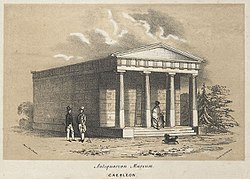National Roman Legion Museum
| National Roman Legion Museum | |
|
Monmouthshire | |
|---|---|
 The National Roman Legion Museum, Caerleon | |
| Type: | Museum |
| Location | |
| Grid reference: | ST33949057 |
| Location: | 51°36’36"N, 2°57’19"W |
| Town: | Caerleon |
| History | |
| Museum | |
| Information | |
| Owned by: | [Amgueddfa Cymry – National Museum Wales |
| Website: | museumwales.ac.uk/roman |
The National Roman Legion Museum is a museum in Caerleon, Monmouthshire. It is one of three Roman sites in Caerleon, along with the Baths museum and the open-air ruins of the amphitheatre and barracks. It is part of the wider network of Amgueddfa Cymru – National Museum Wales.
History
- Main article: Isca Augusta
During the Roman period, the fortress at Isca Augusta, now Caerleon, served as a strongpoint on the narrow pass between the lands of the Severn and those of Glamorgan. It was built in 75 AD, and was one of only three permanent Roman Legionary fortresses in Britain. It was occupied and operational for just over 200 years.
The National Roman Legion Museum lies inside what remains of the fortress, and contains many artefacts from the period of Isca Augusta of Legio II Augusta from Roman currency to uniforms.
A short walk from the National Roman Legion Museum is the remains of Isca Augusta:
- Part of the military bath house in the Roman Baths Museum
- The most complete Roman amphitheatre in Britain
- Sections of the fortress walls
- The only remains of a Roman legionary barracks on view anywhere in Europe at Prysg Field
Museum

The museum is located in the centre of Roman Isca, on what was the via principalis leading to the amphitheatre.[1]
The first museum building was the Antiquarian Museum of 1850. This was built to a design by Henry Francis Lockwood of Hull, a simple box-shaped building of Bath stone. Its only architectural feature of note was the pillared portico in the Greek Doric style. Little is known of the original building but it is known to have re-used ship's timbers in its roof and stone details from the Old Market House of Caerleon which had been demolished shortly before.[2] It is often claimed that the timbers are from HMS Collingwood, although this ship was in service at the time and had no obvious connection to Newport.
The museum building was Grade II listed in 1951, but was largely demolished during the 1987 rebuilding and enlargement of the museum.[3] Only the portico now remains. The new building is in a modernist style, but equally featureless and windowless as the original.
As of February 2019, the site is being redeveloped and is closed to the public until autumn 2019. It will continue to offer facilities for local schools.

See also
Outside links
| ("Wikimedia Commons" has material about National Roman Legion Museum) |
- National Roman Legion Museum
- Six pages of artifacts held within the museum and relating to Roman Caerleon at Gathering the Jewels
References
- ↑ 'Caerleon Roman Fortress' (Cadw, 2003) ISBN 1-85760-159-9; page 19
- ↑ Site details: Caerleon Roman Legionary Museum, Roman Lodge, Caerleon (RCAHMW)
- ↑ "Ashlar Doric portico at The Roman Legionary Museum, Caerleon". http://www.britishlistedbuildings.co.uk/wa-2990-ashlar-doric-portico-at-the-roman-legionar#.Vk4ZMr9fNgA.